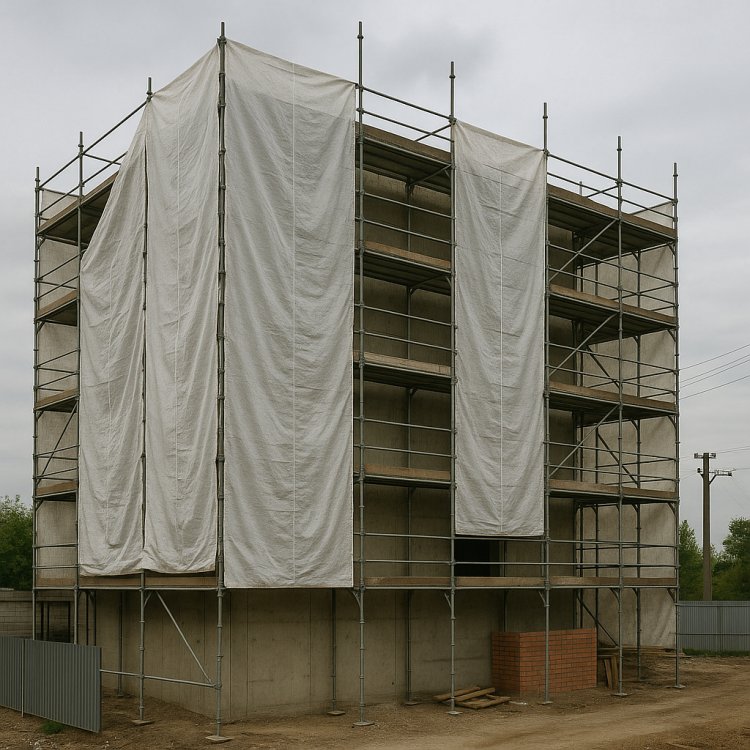How to Use Tarpaulin On a Construction Sites
A Tarpaulin Sheet is a waterproof, sturdy covering used to guard equipment, workers, and supplies against the elements.

Regarding construction, one of the most neglected but crucial materials is the tarpaulin. A tarpaulin will significantly help you whether you are constructing a small house, a massive business building, or doing renovations. maintaining the order, hygiene, and safety of your website. A Tarpaulin Sheet is a waterproof, sturdy covering used to guard equipment, workers, and supplies against the elements. A need-have on any building site, it's a basic fix with a broad range of applications.
Understanding the Role of Tarpaulin
It's crucial to know what tarpaulin is and why it's significant before you can use it well. Made of canvas, polyethylene, or PVC, a tarpaulin is a sturdy, flexible sheet. It is laminated or coated to give it weather- and water resistance. Tarpaulins are employed on construction sites to shield building materials, provide short-term housing, and guard against harm from dust, rain, or sunshine.
When you want defense without obscuring light, a Clear Tarpaulin is very helpful. Clear tarpaulin, for instance, lets in natural light while blocking wind and moisture when used indoors or when it's chilly. This makes it perfect for covering open walls or unfinished roofs while yet allowing interior visibility.
Protecting Building Materials
On a construction site, a tarpaulin sheet is primarily used to keep things safe from the elements. Cement, sand, steel, and wood are all building materials that are sensitive to heat and moisture. Rain can crack timber, rust steel bars, and ruin cement bags. Covering these things with a tarpaulin sheet will help you keep them from getting damaged and wasted.
Make certain a tarpaulin used for protection is firmly fixed. Particularly in gusty weather, use ropes or hefty weights to help it stay in place. If at all feasible, raise the contents a little off the ground to promote air circulation and prevent water gathering under. Your project will save time and money if the materials are correctly covered and kept dry and in good shape.
Creating Temporary Shelters and Work Areas
Temporary workspace for cutting, welding, or tool storage is frequently required at construction sites. In those circumstances, tarpaulin can be utilized to construct rapid temporary buildings. Covering a frame with a big Tarpaulin Sheet can serve as a roof to shield from rain and give shade on warm days. For those who have jobs needing precision, this is quite useful as it offers a safe and dry space to do their work.
For masking places where visibility is crucial, a Clear Tarpaulin may be especially useful. For example, during the day, a clear sheet lets sunshine pass through, which cuts down on the need for artificial light when a part of a site is being closed off for interior work. It also enables supervisors to monitor continuous work without needing to remove the cover frequently.
Containing Dust and Debris
Construction work by its very nature creates dust, trash, and other waste products. For hygiene and environmental concerns as well as for safety, keeping these under control is very important. To prevent dust from reaching adjacent places, tarpaulin sheets may serve as screens or barriers. If you're grinding or cutting materials, for instance, hanging tarpaulin sheets around the workplace might assist to manage dust.
Utilizing a Clear Tarpaulin in these situations lets you keep visibility while yet managing dust under check. In particular in metropolitan building sites where laws mandate actions to stop air pollution and guarantee the safety of adjacent pedestrians, this is quite helpful.
Covering Unfinished Structures
Sometimes during the building process, a structure is just partly finished but still exposed to the elements. Rain or direct sunlight may quickly damage roofs, walls, and floors not yet sealed. Covering these places with tarpaulins keeps the building stable until the long-term coverings are put on.
For instance, concrete slabs should be shielded from too much sunlight after installation to avoid cracking. One can shade the area with a tarpaulin sheet and manage the curing process. Likewise, tarpaulin covering the building's top keeps the inside dry should roofing work be postponed.
If you want to protect but yet allow natural light to pass through, a Clear Tarpaulin is a good option. It can temporarily cover windows or holes while construction is underway without compromising workers' inside sight. It also prevents the area from becoming overly dark.
Safety Uses of Tarpaulin on Site
On any building site, safety is a main concern; tarpaulins can help with this as well. They can be used to build safety barriers surrounding dangerous locations, therefore blocking illegal entry. Tarpaulins help keep falling materials from injuring people or bystanders when they are put on scaffolding.
Tarpaulins can also assist to keep specific sections dry, so preserving safe walking routes in cases of strong rain or storms. Strong eyelets on a tarpaulin sheet can be used to make temporary walls or roofs that keep workers and equipment safe from danger.
Choosing the Right Type of Tarpaulin
Not every tarpaulin is similar. Your particular requirements at the construction site will determine the best option. Thick polyethylene or PVC tarpaulins are perfect for demanding outdoor work as they can resist heavy rain and powerful winds. For temporary or indoor coverings, lightweight solutions could suffice.
Should natural light or visibility be important to you, a Clear Tarpaulin is the ideal pick. It's ideal for interior settings or small spaces since it lets light in while also offering shielding. Conversely, a colored or opaque Tarpaulin Sheet is preferable for privacy or complete sun protection.
Before buying, always verify the diameter and thickness. While a bigger and heavier tarpaulin covers more ground and lasts longer, it might be harder to handle. Its lifespan will also be increased by good care, like cleaning and drying after usage.
Maintenance and Storage
It is imperative to keep tarpaulin stored properly after using it on a building site. Fold it neatly and store it somewhere dry to help avoid mildew or mold. Keep it out of the sun for lengthy lengths of time when not in use, as UV rays can weaken the material over time. Check regularly for tears or holes and fix them right away to guarantee greatest future protection. Your Clear Tarpaulin or Tarpaulin Sheet will be ready for reuse in other projects if you take good care of it, which makes it a worthwhile purchase for your building company. Read More Articles
Conclusion
Though tarpaulins could seem like a basic tool, their value on construction sites is almost beyond words. They fulfill many goals ranging from preserving materials and building homes to upholding cleanliness and safety, therefore facilitating a safer, more seamless building process. An economical and adaptable fix that saves time, lowers waste, and safeguards precious goods is a Tarpaulin Sheet. A Clear Tarpaulin is ideal for circumstances requiring light and visibility since it strikes just the right mix of usefulness and safety.


 tarpaulinsworld
tarpaulinsworld 



















